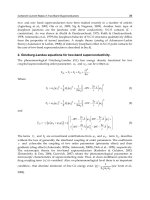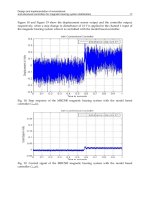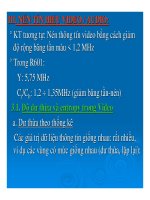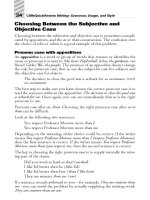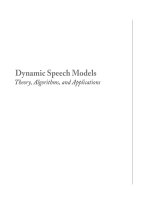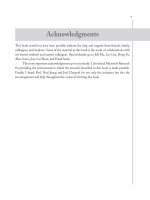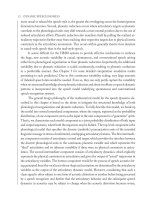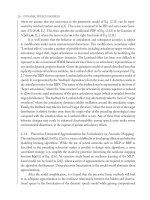Dynamic Speech ModelsTheory, Algorithms, and Applications phần 3 pot
Bạn đang xem bản rút gọn của tài liệu. Xem và tải ngay bản đầy đủ của tài liệu tại đây (302.8 KB, 14 trang )
P1: IML/FFX P2: IML
MOBK024-02 MOBK024-LiDeng.cls May 30, 2006 12:56
12 DYNAMIC SPEECH MODELS
more casual or relaxed the speech style is, the greater the overlapping across the feature/gesture
dimensions becomes. Second, phonetic reduction occurs where articulatory targets as phonetic
correlates to the phonological units may shift towards a more neutral position due to the use of
reduced articulatory efforts. Phonetic reduction also manifests itself by pulling the realized ar-
ticulatory trajectories further away from reaching their respective targets due to physical inertia
constraints in the articulatory movements. This occurs within generally shorter time duration
in casual-style speech than in the read-style speech.
It seems difficult for the HMM systems to provide effective mechanisms to embrace
the huge, new acoustic variability in casual, spontaneous, and conversational speech arising
either from phonological organization or from phonetic reduction. Importantly, the additional
variability due to phonetic reduction is scaled continuously, resulting in phonetic confusions
in a predictable manner. (See Chapter 5 for some detailed computation simulation results
pertaining to such prediction.) Due to this continuous variability scaling, very large amounts
of (labeled) speech data would be needed. Even so, they can only partly capture the variability
when no structured knowledge about phonetic reductionandaboutitseffectsonspeechdynamic
patterns is incorporated into the speech model underlying spontaneous and conversational
speech-recognition systems.
The general design philosophy of the mathematical model for the speech dynamics de-
scribed in this chapter is based on the desire to integrate the structured knowledge of both
phonological reorganization and phonetic reduction. To fully describe this model, we break up
the model into several interrelated components, where the output, expressed as the probability
distribution, of onecomponent serves as theinput to the next component in a“generative” spirit.
That is, we characterize each model component as a joint probability distribution of both input
and output sequences,where both the sequences may be hidden.The top-level component is the
phonological model that specifies the discrete (symbolic) pronunciation units of the intended
linguistic message in terms of multitiered, overlapping articulatory features. The first intermedi-
ate component consists of articulatory control and target, which provides the interface between
the discrete phonological units to the continuous phonetic variable and which represents the
“ideal” articulation and its inherent variability if there were no physical constraints in articu-
lation. The second intermediate component consists of articulatory dynamics, which explicitly
represents the physical constraints in articulation and gives the output of “actual” trajectories in
the articulatory variables. The bottom component would be the process of speech acoustics be-
ing generated from the vocal tract whose shape and excitation are determined by the articulatory
variables as the output of the articulatory dynamic model. However, considering that such a
clean signal is often subject to one form of acoustic distortion or another before being processed
by a speech recognizer, and further that the articulatory behavior and the subsequent speech
dynamics in acoustics may be subject to change when the acoustic distortion becomes severe,
P1: IML/FFX P2: IML
MOBK024-02 MOBK024-LiDeng.cls May 30, 2006 12:56
A GENERAL MODELING AND COMPUTATIONAL FRAMEWORK 13
we complete the comprehensive model by adding the final component of acoustic distortion
with feedback to the higher level component describing articulatory dynamics.
2.3 MODEL COMPONENTS AND THE COMPUTATIONAL
FRAMEWORK
In a concrete form, the generative model for speech dynamics, whose design philosophy and
motivations have been outlined in the preceding section, consists of the hierarchically structured
components of
1. multitiered phonological construct (nonobservable or hidden; discrete valued);
2. articulatory targets (hidden; continuous-valued);
3. articulatory dynamics (hidden; continuous);
4. acoustic pattern formation from articulatory variables (hidden; continuous); and
5. distorted acoustic pattern formation (observed; continuous).
In this section, we will describe each of these components and their design in some detail.
In particular, as a general computational framework, we provide the DBN representation for
each of the above model components and for their combination.
2.3.1 Overlapping Model for Multitiered Phonological Construct
Phonology is concerned with sound patterns of speech and with the nature of the discrete
or symbolic units that shapes such patterns. Traditional theories of phonology differ in the
choice and interpretation of the phonological units. Early distinctive feature-based theory [61]
and subsequent autosegmental, feature-geometry theory [62] assumed a rather direct link be-
tween phonological features and their phonetic correlates in the articulatory or acoustic domain.
Phonological rules for modifying features represented changes not only in the linguistic struc-
ture of the speech utterance, but also in the phonetic realization of this structure. This weakness
has been recognized by more recent theories, e.g., articulatory phonology [63], which empha-
size the importance of accounting for phonetic levels of variation as distinct from those at the
phonological levels.
In the phonological model component described here, it is assumed that the linguis-
tic function of phonological units is to maintain linguistic contrasts and is separate from
phonetic implementation. It is further assumed that the phonological unit sequence can be
described mathematically by a discrete-time, discrete-state, multidimensional homogeneous
Markov chain. How to construct sequences of symbolic phonological units for any arbitrary
speech utterance and how to build them into an appropriate Markov state (i.e., phonological
state) structure are two key issues in the model specification. Some earlier work on effective
P1: IML/FFX P2: IML
MOBK024-02 MOBK024-LiDeng.cls May 30, 2006 12:56
14 DYNAMIC SPEECH MODELS
methods of constructing such overlapping units, either by rules or by automatic learning, can
be found in [50, 59, 64–66]. In limited experiments, these methods have proved effective for
coarticulation modeling in the HMM-like speech recognition framework (e.g., [50,65]).
Motivated by articulatory phonology [63], the asynchronous, feature-based phonological
model discussed here uses multitiered articulatory features/gestures that are temporally over-
lapping with each other in separate tiers, with learnable relative-phasing relationships. This
contrasts with most existing speech-recognition systems where the representation is based on
phone-sized units with one single tier for the phonological sequence acting as “beads-on-a-
string.” This contrast has been discussed in some detail in [11] with useful insight.
Mathematically, the L-tiered, overlapping model can be described by the “factorial”
Markov chain [51, 67], where the state of the chain is represented by a collection of discrete-
component state variables for each time frame t:
s
t
= s
(1)
t
, ,s
(l)
t
, ,s
(L)
t
.
Each of the component states can take K
(l)
values. In implementing this model for American
English, we have L = 5, and the five tiers are Lips, Tongue Blade, Tongue Body, Velum, and
Larynx, respectively. For “Lips” tier, we have K
(1)
= 6 for six possible linguistically distinct Lips
configurations, i.e., those for /b/, /r/, /sh/, /u/, /w/, and /o/. Note that at this phonological level,
the difference among these Lips configurations is purely symbolic. The numerical difference is
manifested in different articulatory target values at lower phonetic level, resulting ultimately in
different acoustic realizations. For the remaining tiers, we have K
(2)
= 6, K
(3)
= 17, K
(4)
= 2,
and K
(5)
= 2.
The state–space of this factorial Markov chain consists of all K
L
= K
(1)
× K
(2)
× K
(3)
×
K
(4)
× K
(5)
possible combinations of the s
(l)
t
state variables. If no constraints are imposed on
the state transition structure, this would be equivalent to the conventional one-tiered Markov
chain with a total of K
L
states and a K
L
× K
L
state transition matrix. This would be an unin-
teresting case since the model complexity is exponentially (or factorially) growing in L. It would
also be unlikely to find any useful phonological structure in this huge Markov chain. Further,
since all the phonetic parameters in the lower level components of the overall model (to be
discussed shortly) are conditioned on the phonological state, the total number of model param-
eters would be unreasonably large, presenting a well-known sparseness difficulty for parameter
learning.
Fortunately, rich sources of phonological and phonetic knowledge are available to
constrain the state transitions of the above factorial Markov chain. One particularly useful set
of constraints come directly from the phonological theories that motivated the construction
of this model. Both autosegmental phonology [62] and articulatory phonology [63] treat the
different tiers in the phonological features as being largely independent of each other in their
P1: IML/FFX P2: IML
MOBK024-02 MOBK024-LiDeng.cls May 30, 2006 12:56
A GENERAL MODELING AND COMPUTATIONAL FRAMEWORK 15
)1(
1
S
)1(
2
S
)1(
3
S
)1(
4
S
)1(
T
S
)2(
1
S
)2(
2
S
)2(
3
S
)2(
4
S
)2(
T
S
)(
1
L
S
)(
2
L
S
)(
3
L
S
)(
4
L
S
)(L
T
S
FIGURE 2.1: A dynamic Bayesian network (DBN) for a constrained factorial Markov chain as a prob-
abilistic model for an L-tiered overlapping phonological model based on articulatory features/gestures.
The constrained transition structure in the factorial Markov chain makes different tiers in the phono-
logical features independent of each other in their evolving dynamics. This gives rise to parallel streams,
s
(l)
, l = 1, 2, ,L, of the phonological features in their associated articulatory dimensions
evolving dynamics. This thus allows the a priori decoupling among the L tiers:
P(s
t
|s
t−1
) =
L
l=1
P(s
(l)
t
|s
(l)
t−1
).
The transition structure of this constrained (uncoupling) factorial Markov chain can be
parameterized by L distinct K
(l)
× K
(l)
matrices. This is significantly simpler than the original
K
L
× K
L
matrix as in the unconstrained case.
Fig. 2.1 shows a dynamic Bayesian network (DBN) for a factorial Markov chain with
the constrained transition structure. A Bayesian network is a graphical model that describes
dependencies and conditional independencies in the probabilistic distributions defined over a
set of random variables. The most interesting class of Bayesian networks, as relevant to speech
modeling, is the DBN specifically aimed at modeling time series data or symbols such as speech
acoustics, phonological units, or a combination of them. For the speech data or symbols, there
are causal dependencies between random variables in time and they are naturally suited for the
DBN representation.
In the DBN representation of Fig. 2.1 for the L-tiered phonological model, each node
represents a component phonological feature in each tier as a discrete random variable at a
particular discrete time. The fact that there is no dependency (lacking arrows) between the
P1: IML/FFX P2: IML
MOBK024-02 MOBK024-LiDeng.cls May 30, 2006 12:56
16 DYNAMIC SPEECH MODELS
nodes in different tiers indicates that each tier is autonomous in the evolving dynamics. We
call this model the overlapping model, reflecting the independent dynamics of the features
at different tiers. The dynamics cause many possible combinations in which different feature
values associated with their respective tiers occur simultaneously at a fixed time point. These are
determined by how the component features/gestures overlap with each other as a consequence
of their independent temporal dynamics. Contrary to this view, in the conventional phone-
based phonological model, there is only one single tier of phones as the “bundled” component
features, and hence there is no concept of overlapping component features.
In a DBN, the dependency relationships among the random variables can be implemented
by specifying the associated conditional probability for each node given all its parents. Because
of the decoupled structure across the tiers as shown in Fig. 2.1, the horizontal (temporal)
dependency is the only dependency that exists for the component phonological (discrete) states.
This dependency can be specified by the Markov chain transition probability for each separate
tier, l, defined by
P
s
(l)
t
= j|s
(l)
t−1
= i
= a
(l)
ij
. (2.1)
2.3.2 Segmental Target Model
After a phonological model is constructed, the process for converting abstract phonological units
into their phonetic realization needs to be specified. The key issue here is whether the invariance
in the speech process is more naturally expressed in the articulatory or the acoustic/auditory
domain. A number of theories assumed a direct link between abstract phonological units and
physical measurements. For example, the “quantal theory” [68] proposed that phonological
features possessed invariant acoustic (or auditory) correlates that could be measured directly
from the speech signal. The “motor theory” [69] instead proposed that articulatory properties
are directly associated with phonological symbols. No conclusive evidence supporting either
hypothesis has been found without controversy [70].
In the generative model of speech dynamics discussed here, one commonly held view
in phonetics literature is adopted. That is, discrete phonological units are associated with a
temporal segmental sequence of phonetic targets or goals [71–75]. In this view, the function
of the articulatory motor control system is to achieve such targets or goals by manipulating the
articulatory organs according to some control principles subject to the articulatory inertia and
possibly minimal-energy constraints [60].
Compensatory articulation has been widely documented in the phonetics literature where
trade-offs between different articulators and nonuniqueness in the articulatory–acoustic map-
ping allow for the possibility that many different articulatory target configurations may be
able to “equivalently” realize the same underlying goal. Speakers typically choose a range
P1: IML/FFX P2: IML
MOBK024-02 MOBK024-LiDeng.cls May 30, 2006 12:56
A GENERAL MODELING AND COMPUTATIONAL FRAMEWORK 17
of possible targets depending on external environments and their interactions with listen-
ers [60, 70, 72, 76, 77]. To account for compensatory articulation, a complex phonetic control
strategy need to beadopted. The key modeling assumptions adoptedhere regarding such a strat-
egy are as follows. First, each phonological unit is correlated to a number of phonetic parameters.
These measurable parameters may be acoustic, articulatory, or auditory in nature, and they can
be computed from some physical models for the articulatory and auditory systems. Second, the
region determined by the phonetic correlates for each phonological unit can be mapped onto
an articulatory parameter space. Hence, the target distribution in the articulatory space can
be determined simply by stating what the phonetic correlates (formants, articulatory positions,
auditory responses, etc.) are for each of the phonological units (many examples are provided
in [2]), and by running simulations in detailed articulatory and auditory models. This particular
proposal for using the joint articulatory, acoustic, and auditory properties to specify the artic-
ulatory control in the domain of articulatory parameters was originally proposed in [59, 78].
Compared with the traditional modeling strategy for controlling articulatory dynamics [79]
where the sole articulatory goal is involved, this new strategy appears more appealing not only
because of the incorporation of the perceptual and acoustic elements in the specification of the
speech production goal, but also because of its natural introduction of statistical distributions
at the relatively high level of speech production.
A convenient mathematical representation for the distribution of the articulatory target
vector t follows a multivariate Gaussian distribution, denoted by
t ∼ N(t; m(s),(s)), (2.2)
where m(s) is the mean vector associated with the composite phonological state s, and
the covariance matrix (s) is nondiagonal. This allows for the correlation among the ar-
ticulatory vector components. Because such a correlation is represented for the articula-
tory target (as a random vector), compensatory articulation is naturally incorporated in the
model.
Since the target distribution, as specified in Eq. (2.2), is conditioned on a specific phono-
logical unit (e.g., a bundle of overlapped features represented by the composite state s consisting
of component feature values in the factorial Markov chain of Fig. 2.1), and since the target does
not switch until the phonological unit changes, the statistics for the temporal sequence of the
target process follows that of a segmental HMM [40].
For the single-tiered (L = 1) phonological model (e.g., phone-based model), the
segmental HMM for the target process will be the same as that described in [40], except
the output is no longer the acoustic parameters. The dependency structure in this segmental
HMM as the combined one-tiered phonological model and articulatory target model can be
illustrated in the DBN of Fig. 2.2. We now elaborate on the dependencies in Fig. 2.2. The
P1: IML/FFX P2: IML
MOBK024-02 MOBK024-LiDeng.cls May 30, 2006 12:56
18 DYNAMIC SPEECH MODELS
1
S
2
S
3
S
4
S
K
S
1
t
2
t
3
t
4
t
K
t
FIGURE2.2: DBN for a segmental HMM as a probabilistic model for the combined one-tiered phono-
logical model and articulatory target model. The output of the segmental HMM is the target vector, t,
constrained to be constant until the discrete phonological state, s , changes its value
output of this segmental HMM is the random articulatory target vector t(k) that is constrained
to be constant until the phonological state switches its value. This segmental constraint for
the dynamics of the random target vector t(k) represents the adopted articulatory control
strategy that the goal of the motor system is to try to maintain the articulatory target’s position
(for a fixed corresponding phonological state) by exerting appropriate muscle forces. That is,
although random, t(k) remains fixed until the phonological state s
k
switches. The switching of
target t(k) is synchronous with that of the phonological state, and only at the time of switching,
is t(k) allowed to take a new value according to its probability density function. This segmental
constraint can be described mathematically by the following conditional probability density
function:
p[t(k)|s
k
, s
k−1
, t(k − 1)] =
δ[t(k) −t(k −1)] if s
k
= s
k−1
,
N(t(k); m(s
k
),(s
k
)) otherwise.
This adds the new dependencies of random vector of t(k)ons
k−1
and t(k −1), in addition to
the obvious direct dependency on s
k
, as shown in Fig. 2.2.
Generalizing from the one-tiered phonological model to the multitiered one as discussed
earlier, the dependency structure in the “segmental factorial HMM” as the combined multitiered
phonological model and articulatory target model has the DBN representation in Fig. 2.3. The
key conditional probability density function (PDF) is similar to the above segmental HMM
except that the conditioning phonological states are the composite states (s
k
and s
k−1
) consisting
of a collection of discrete component state variables:
p[t(k)|s
k
, s
k−1
, t(k − 1)] =
δ[t(k) −t(k −1)] if s
k
= s
k−1
,
N(t(k); m(s
k
),(s
k
)) otherwise.
Note that in Figs. 2.2 and 2.3 the target vector t(k) is defined in the same space as that of
the physical articulator vector (including jaw positions, which do not have direct phonological
P1: IML/FFX P2: IML
MOBK024-02 MOBK024-LiDeng.cls May 30, 2006 12:56
A GENERAL MODELING AND COMPUTATIONAL FRAMEWORK 19
)1(
1
S
)1(
2
S
)1(
3
S
)1(
4
S
)1(
T
S
)2(
1
S
)2(
2
S
)2(
3
S
)2(
4
S
)2(
T
S
)(
1
L
S
)(
2
L
S
)(
3
L
S
)(
4
L
S
)(L
T
S
1
t
2
t
3
t
K
t
4
t
FIGURE2.3: DBN for a segmental factorial HMM as a combined multitiered phonological model and
articulatory target model
connections). And compensatory articulation can be represented directly by the articulatory
target distributions with a nondiagonal covariance matrix for component correlation. This
correlation shows how the various articulators can be jointly manipulated in a coordinated
manner to produce the same phonetically implemented phonological unit.
An alternative model for the segmental target model, as proposed in [33] and called the
“target dynamic” model, uses vocal tract constrictions (degrees and locations) instead of artic-
ulatory parameters as the target vector, and uses a geometrically defined nonlinear relationship
(e.g., [80]) to map one vector of vocal tract constrictions into a region (with a probability dis-
tribution) of the physical articulatory variables. In this case, compensatory articulation can also
be represented by the distributional region of the articulatory vectors induced indirectly by any
fixed vocal tract constriction vector.
The segmental factorial HMM presented here is a generalization of the segmental HMM
proposed originally in [40]. It is also a generalization of the factorial HMM that has been
developed from the machine learning community [67] and been applied to speech recognition
[51]. These generalizations are necessary because the output of our component model (not the
full model) is physically the time-varying articulatory targets as random sequences, rather than
the random acoustic sequences as in the segmental HMM or the factorial HMM.
P1: IML/FFX P2: IML
MOBK024-02 MOBK024-LiDeng.cls May 30, 2006 12:56
20 DYNAMIC SPEECH MODELS
2.3.3 Articulatory Dynamic Model
Due to the difficulty in knowing how the conversion of higher-level motor control into artic-
ulator movement takes place, a simplifying assumption is made for the new model component
discussed in this subsection. That is, we assume that at the functional level the combined (non-
linear) control system and articulatory mechanism behave as a linear dynamic system. This
combined system attempts to track the control input, equivalently represented by the articu-
latory target, in the physical articulatory parameter space. Articulatory dynamics can then be
approximated as the response of a linear filter driven by a random target sequence as represented
by a segmental factorial HMM just described. The statistics of the random target sequence ap-
proximate those of the muscle forces that physically drives motions of the articulators. (The
output of this hidden articulatory dynamic model then produces a time-varying vocal tract
shape that modulates the acoustic properties of the speech signal.)
The above simplifying assumption then reduces the generally intractable nonlinear state
equation,
z(k + 1) = g
s
[z(k), t
s
, w(k)],
into the following mathematically tractable, linear, first-order autoregressive (AR) model:
z(k + 1) = A
s
z(k) +B
s
t
s
+ w(k), (2.3)
where z is the n-dimensional real-valued articulatory-parameter vector, w is the IID and Gaus-
sian noise, t
s
is the HMM-state-dependent target vector expressed in the same articulatory
domain as z(k), A
s
is the HMM-state-dependent system matrix, and B
s
is a matrix that mod-
ifies the target vector. The dependence of t
s
and
s
parameters of the above dynamic system
on the phonological state is justified by the fact that the functional behavior of an articulator
depends both on the particular goal it is trying to implement, and on the other articulators with
which it is cooperating in order to produce compensatory articulation.
In order for the modeled articulatory dynamics above to exhibit realistic behaviors, e.g.,
movement along the target-directed path within each segment and not oscillating within the
segment, matrices A
s
and B
s
can be constrained appropriately. One form of the constraint gives
rise to the following articulatory dynamic model:
z(k + 1) =
s
z(k) +(I −
s
)t
s
+ w(k), (2.4)
where I is the identity matrix. Other forms of the constraint will be discussed in Chapters 4
and 5 of the book for two specific implementions of the general model.
It is easy to see that the constrained linear AR model of Eq. (2.4) has the desirable target-
directed property. That is, the articulatory vector z(k) asymptotically approaches the mean of
the target random vector t for artificially lengthened speech utterances. For natural speech, and
P1: IML/FFX P2: IML
MOBK024-02 MOBK024-LiDeng.cls May 30, 2006 12:56
A GENERAL MODELING AND COMPUTATIONAL FRAMEWORK 21
especially for conversational speech with a casual style, the generally short duration associated
with each phonological state forces the articulatory dynamics to move away from the target
of the current state (and towards the target of the following phonological state) long before it
reaches the current target. This gives rise to phonetic reduction, and is one key source of speech
variability that is difficult to be directly captured by a conventional HMM.
Including the linear dynamic system model of Eq. (2.4), the combined phonological,
target, and articulatory dynamic model now has the DBN representation of Fig. 2.4. The new
dependency for the continuous articulatory state is specified, on the basis of Eq. (2.4), by the
following conditional PDF:
p
z
[z(k + 1)|z(k), t(k), s
k
] = p
w
[z(k + 1) −
s
k
z(k) −(I −
s
k
)t(k)]. (2.5)
This combined model is a switching, target-directed AR model driven by a segmental factorial
HMM.
)1(
1
S
)1(
2
S
)1(
3
S
)1(
4
S
)1(
T
S
)2(
1
S
)2(
2
S
)2(
3
S
)2(
4
S
)2(
T
S
)(
1
L
S
)(
2
L
S
)(
3
L
S
)(
4
L
S
)(L
T
S
1
t
2
t
3
t
K
t
4
t
1
z
2
z
3
z
K
z
4
z
FIGURE 2.4: DBN for a switching, target-directed AR model driven by a segmental factorial HMM.
This is a combined model for multitiered phonology, target process, and articulatory dynamics
P1: IML/FFX P2: IML
MOBK024-02 MOBK024-LiDeng.cls May 30, 2006 12:56
22 DYNAMIC SPEECH MODELS
2.3.4 Functional Nonlinear Model for Articulatory-to-Acoustic Mapping
The next component in the overall model of speech dynamics moves the speech generative
process from articulation down to distortion-free speech acoustics. While a truly consistent
framework to accomplish this based on explicit knowledge of speech production should include
detailed mechanisms for articulatory-to-acoustic generation, this becomes impractical due to
difficulties in modeling learning and excessive computational requirements. Again, we make
the simplifying assumptions that the articulatory and acoustic states of the vocal tract can be
adequately described by low-order vectors of variables, where the articulatory state variables
represent respectively the relative positions of the major articulators, and the acoustic state
variables represent corresponding time-averaged spectral-like parameters computed from the
acoustic signal. If an appropriate time scale is chosen, the relationship between the articulatory
and acoustic representations can be modeled by a static memoryless transformation, converting
a vector of articulatory parameters into a vector of acoustic ones. This assumption appears
reasonable for a vocal tract with about 10-ms reverberation time.
This static memoryless transformation can be mathematically represented by the follow-
ing “observation” equation in the state–space model:
o(k) = h[z(k)] + v(k), (2.6)
where o is the m-dimensional real-valued observation vector, v is the IID observation noise
vector uncorrelated with the state noise w, and h[·] is the static memoryless transformation
from the articulatory vector to its corresponding acoustic observation vector.
Including this static mapping model, the combined phonological, target, articulatory
dynamic, and the acoustic model now has the DBN representation shown in Fig. 2.5. The new
dependency for the acoustic random variables is specified, on the basis of “observation” equation
in Eq. (2.6), by the following conditional PDF:
p
o
[o(k) |z(k)] = p
v
[o(k) −h(z(k))]. (2.7)
There aremanyways of choosing the static nonlinear function for h[z] in Eq. (2.6), suchas
using a multilayerperceptron (MLP) neuralnetwork. Typically, the analytical forms of nonlinear
functions make the associated nonlinear dynamic systems difficult to analyze and make the
estimation problems difficult to solve. Simplification is frequently used to gain computational
advantages while sacrificing accuracy for approximating the nonlinear functions. One most
commonly used technique for the approximation is truncated (vector) Taylor series expansion.
If all the Taylor series terms of order two and higher are truncated, then we have the linear
Taylor series approximation that is characterized by the Jacobian matrix J and by the point of
Taylor series expansion z
0
:
h(z) ≈ h(z
0
) + J(z
0
)(z − z
0
). (2.8)
P1: IML/FFX P2: IML
MOBK024-02 MOBK024-LiDeng.cls May 30, 2006 12:56
A GENERAL MODELING AND COMPUTATIONAL FRAMEWORK 23
)1(
1
S
)1(
2
S
)1(
3
S
)1(
4
S
)1(
T
S
)2(
1
S
)2(
2
S
)2(
3
S
)2(
4
S
)2(
T
S
)(
1
L
S
)(
2
L
S
)(
3
L
S
)(
4
L
S
)(L
T
S
1
t
2
t
3
t
K
t
4
t
1
z
2
z
3
z
K
z
4
z
1
o
2
o
3
o
K
o
4
o
FIGURE2.5: DBN for atarget-directed,switchingdynamic system (state–space)modeldriven by a seg-
mental factorial HMM. This is a combined model for multitiered phonology, target process, articulatory
dynamics, and articulatory-to-acoustic mapping
Each element of the Jacobian matrix J is partial derivative of each vector component of the
nonlinear output with respect to each of the input vector components. That is,
J(z
0
) =
∂h
∂z
0
=
⎡
⎢
⎢
⎢
⎢
⎢
⎣
∂h
1
(z
0
)
∂z
1
∂h
1
(z
0
)
∂z
2
···
∂h
1
(z
0
)
∂z
n
∂h
2
(z
0
)
∂z
1
∂h
2
(z
0
)
∂z
2
···
∂h
2
(z
0
)
∂z
n
.
.
.
.
.
.
∂h
m
(z
0
)
∂z
1
∂h
m
(z
0
)
∂z
2
···
∂h
m
(z
0
)
∂z
n
⎤
⎥
⎥
⎥
⎥
⎥
⎦
. (2.9)
P1: IML/FFX P2: IML
MOBK024-02 MOBK024-LiDeng.cls May 30, 2006 12:56
24 DYNAMIC SPEECH MODELS
The radial basis function (RBF) is an attractive alternative to the MLP as a universal
function approximator [81] for implementing the articulatory-to-acoustic mapping. Use of the
RBF for a nonlinear function in the general nonlinear dynamic system model can be found
in [82], and will not be elaborated here.
2.3.5 Weakly Nonlinear Model for Acoustic Distortion
In practice, the acoustic vector of speech, o(k), generated from the articulatory vector z(k)is
subject to acoustic environmental distortion before being “observed” and being processed by a
speech recognizer for linguistic decoding. In many cases of interest, acoustic distortion can be
accurately characterized by joint additive noise and channel (convolutional) distortion in the
signal-sample domain. In this domain, the distortion is linear and can be described by
y(t) = o(t) ∗
(t) + n(t), (2.10)
where y(t) is the distorted speech signal sample, modeled as convolution between the clean
speech signal sample o(t) and distortion channel’s impulse response
(t) plus additive noise
sample n(t).
However, in the log-spectrum domain or in the cepstrum domain that is commonly used
as the input for speech recognizers, Eq. (2.10)has its equivalent form of (see aderivation in [83])
y(k) = o(k) +¯h + Clog
I + exp[C
−1
(n(k) −o(k) −¯h)]
. (2.11)
In Eq. (2.11), y(k) is the cepstral vector at frame k, when C is taken as cosine transform
matrix. (When C is taken as the identity matrix, y(k) becomes a log-spectral vector.) y(k)now
becomes weakly nonlinearly related to the clean speech cepstral vector o(k), cepstral vector of
additive noise n(k), and cepstral vector of the impulse response of the distortion channel ¯h. Note
that according to Eq. (2.11), the relationship between clean and noisy speech cepstral vectors
becomes linear (or affine) when the signal-to-noise ratio is either very large or very small.
After incorporating the aboveacousticdistortion model,andassuming that thestatisticsof
the additivenoisechangesslowly over timeasgovernedbyadiscrete-state Markovchain,Fig.2.6
shows the DBN for the comprehensive generative model of speech from the phonological
model to distorted speech acoustics. Intermediate models include the target model, articulatory
dynamic model, and clean-speech acoustic model. For clarity, only a one-tiered, rather than
multitiered, phonological model is illustrated. [The dependency of the parameters ()ofthe
articulatory dynamic model on the phonological state is also explicitly added.] Note that in Fig.
2.6, the temporal dependency in the discrete noise states N
k
gives rise to nonstationarity in the
additive noise random vectors n
k
. The cepstral vector ¯h for the distortion channel is assumed
not to change over the time span of the observed distorted speech utterance y
1
, y
2
, ,y
K
.
P1: IML/FFX P2: IML
MOBK024-02 MOBK024-LiDeng.cls May 30, 2006 12:56
A GENERAL MODELING AND COMPUTATIONAL FRAMEWORK 25
1
S
2
S
3
S
4
S
K
S
1
t
2
t
3
t
K
t
4
t
1
z
2
z
3
z
K
z
4
z
1
o
2
o
3
o
K
o
4
o
1
y
2
y
3
y K
y
4
y
1
n
2
n
3
n
K
n
4
n
1
N
2
N
3
N
K
N
4
N
h
FIGURE 2.6: DBN for a comprehensive generative model of speech from the phonological model to
distorted speechacoustics. Intermediatemodelsincludethe targetmodel, articulatory dynamicmodel, and
acoustic model. For clarity, only a one-tiered, rather than multitiered, phonological model is illustrated.
Explicitly added is the dependency of the parameters ((s )) of the articulatory dynamic model on the
phonological state
In Fig. 2.6, the dependency relationship for the new variables of distorted acoustic ob-
servation y(k) is specified, on the basis of observation equation 2.11 where o(k) is specified in
Eq. (5), by the following conditional PDF:
p(y(k) |o(k), n(k), ¯h) = p
(y(k) −o(k) −¯h − C log[I + exp(C
−1
(n(k) −o(k) −¯h))]),
(2.12)
